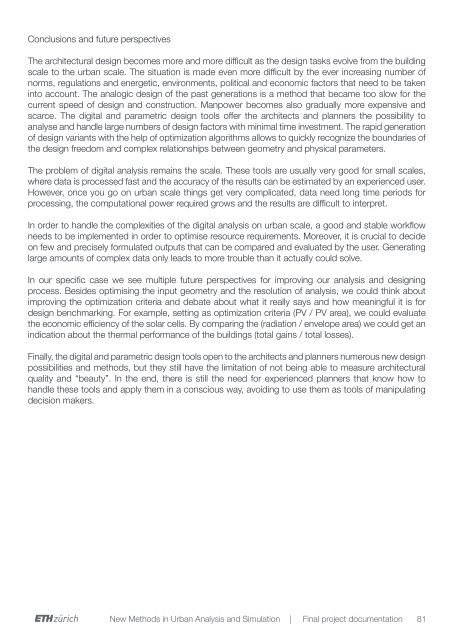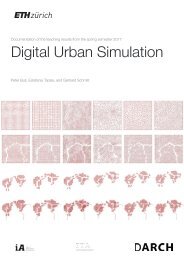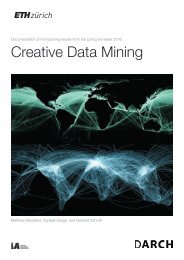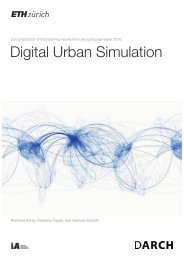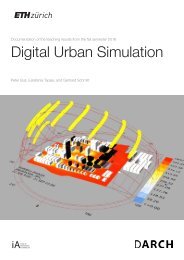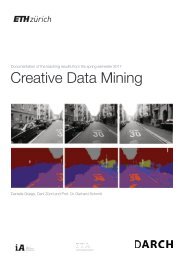Digital Urban Simulation : Documentation of the Teaching Results from the Autumn Semester 2015
Create successful ePaper yourself
Turn your PDF publications into a flip-book with our unique Google optimized e-Paper software.
Conclusions and future perspectives<br />
The architectural design becomes more and more difficult as <strong>the</strong> design tasks evolve <strong>from</strong> <strong>the</strong> building<br />
scale to <strong>the</strong> urban scale. The situation is made even more difficult by <strong>the</strong> ever increasing number <strong>of</strong><br />
norms, regulations and energetic, environments, political and economic factors that need to be taken<br />
into account. The analogic design <strong>of</strong> <strong>the</strong> past generations is a method that became too slow for <strong>the</strong><br />
current speed <strong>of</strong> design and construction. Manpower becomes also gradually more expensive and<br />
scarce. The digital and parametric design tools <strong>of</strong>fer <strong>the</strong> architects and planners <strong>the</strong> possibility to<br />
analyse and handle large numbers <strong>of</strong> design factors with minimal time investment. The rapid generation<br />
<strong>of</strong> design variants with <strong>the</strong> help <strong>of</strong> optimization algorithms allows to quickly recognize <strong>the</strong> boundaries <strong>of</strong><br />
<strong>the</strong> design freedom and complex relationships between geometry and physical parameters.<br />
The problem <strong>of</strong> digital analysis remains <strong>the</strong> scale. These tools are usually very good for small scales,<br />
where data is processed fast and <strong>the</strong> accuracy <strong>of</strong> <strong>the</strong> results can be estimated by an experienced user.<br />
However, once you go on urban scale things get very complicated, data need long time periods for<br />
processing, <strong>the</strong> computational power required grows and <strong>the</strong> results are difficult to interpret.<br />
In order to handle <strong>the</strong> complexities <strong>of</strong> <strong>the</strong> digital analysis on urban scale, a good and stable workflow<br />
needs to be implemented in order to optimise resource requirements. Moreover, it is crucial to decide<br />
on few and precisely formulated outputs that can be compared and evaluated by <strong>the</strong> user. Generating<br />
large amounts <strong>of</strong> complex data only leads to more trouble than it actually could solve.<br />
In our specific case we see multiple future perspectives for improving our analysis and designing<br />
process. Besides optimising <strong>the</strong> input geometry and <strong>the</strong> resolution <strong>of</strong> analysis, we could think about<br />
improving <strong>the</strong> optimization criteria and debate about what it really says and how meaningful it is for<br />
design benchmarking. For example, setting as optimization criteria (PV / PV area), we could evaluate<br />
<strong>the</strong> economic efficiency <strong>of</strong> <strong>the</strong> solar cells. By comparing <strong>the</strong> (radiation / envelope area) we could get an<br />
indication about <strong>the</strong> <strong>the</strong>rmal performance <strong>of</strong> <strong>the</strong> buildings (total gains / total losses).<br />
Finally, <strong>the</strong> digital and parametric design tools open to <strong>the</strong> architects and planners numerous new design<br />
possibilities and methods, but <strong>the</strong>y still have <strong>the</strong> limitation <strong>of</strong> not being able to measure architectural<br />
quality and “beauty”. In <strong>the</strong> end, <strong>the</strong>re is still <strong>the</strong> need for experienced planners that know how to<br />
handle <strong>the</strong>se tools and apply <strong>the</strong>m in a conscious way, avoiding to use <strong>the</strong>m as tools <strong>of</strong> manipulating<br />
decision makers.<br />
New Methods in <strong>Urban</strong> Analysis and <strong>Simulation</strong> | Final project documentation<br />
81


